Huawei P10 and P10 Plus: Performance & Battery Life Report
by Matt Humrick on May 12, 2017 7:00 AM ESTBattery Life
The Huawei P10 pairs the Kirin 960 SoC with a 3200 mAh (12.23 Wh) battery, a small capacity bump from the P9’s 3000 mAh unit. The P10 Plus, which also uses the Kirin 960, gets a battery capacity increase too, up from the P9 Plus’ 3400 mAh to 3750 mAh (14.33 Wh). In our analysis of Kirin 960, we were surprised to see a regression in power efficiency relative to last year’s Kirin 950/955, despite using the newer Cortex-A73 CPU cores that are supposed to consume 20%-30% less power than the Kirin 950’s A72 cores (same process, same frequency), according to ARM; however, the Mate 9 (Kirin 960, 4000 mAh battery) managed to improve battery life relative to the Mate 8 (Kirin 950, 4000 mAh battery) by saving power elsewhere, notably with a more efficient display. Did Huawei find similar power savings with its P10 and P10 Plus?
To find out, we’ll run them through our standard suite of battery tests. To make the tests accurate and repeatable, we control as many variables as possible, including minimizing background tasks and calibrating each display to 200 nits at 100% APL.
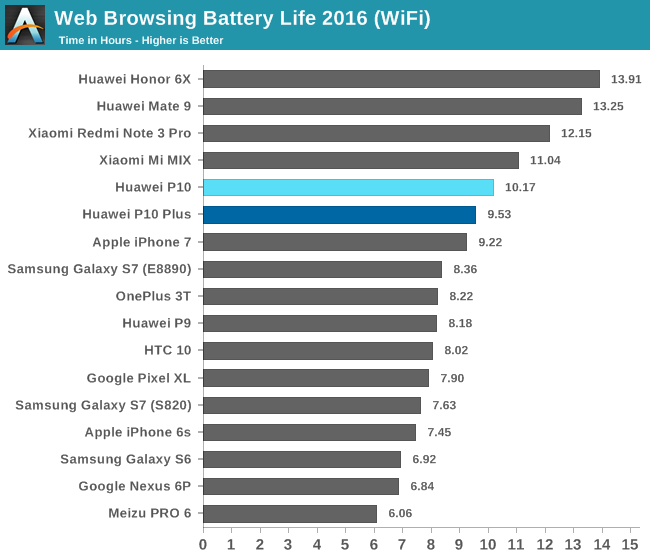
The P10 does quite well in our Wi-Fi browsing test that loads, pauses, and then scrolls through a set of popular websites while connected to Wi-Fi with the cellular radio turned off. Its 10 hours of screen on time is a 2 hour improvement on the P9. It definitely looks like Huawei has shaved power consumption from other components, because this increase is larger than what the bigger battery alone can explain. The P10 Plus uses more power on average than the P10 and its smaller, lower-resolution display, giving it just under 10 hours of screen on time in this test, which is still better than competing phones such as the Galaxy S7, OnePlus 3T, and Google Pixel XL.
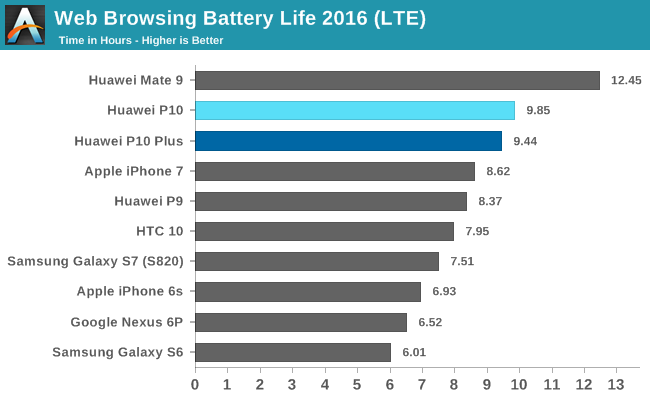
When using the cellular radio instead of Wi-Fi, the P10 once again lasts longer than the P10 Plus. The average platform power consumption (which is extrapolated from total runtime and battery capacity) is once again very similar between the P10 and Mate 9, with the P10 using 276-300mW less power on average than the P10 Plus.
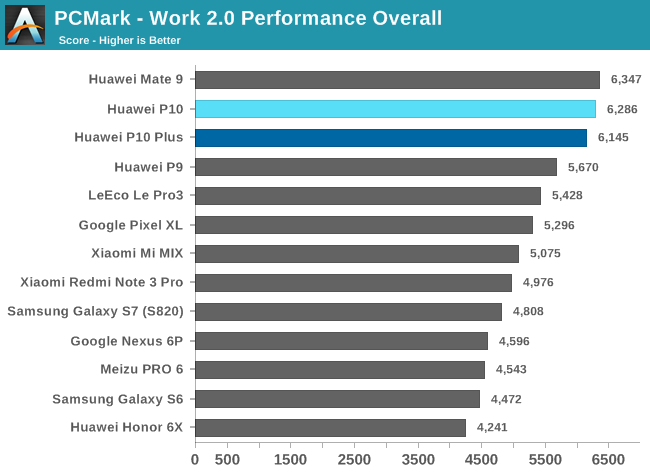
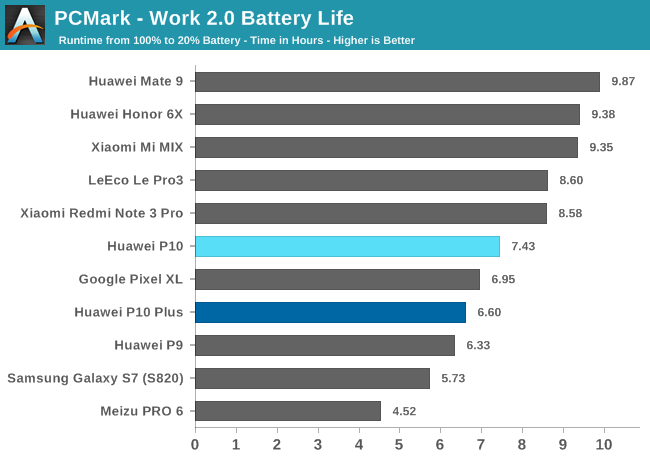
PCMark’s mixture of everyday workloads make better use of the CPU, GPU, and memory subsystems than our browsing battery life tests, which are still mostly limited by the power consumption of the display. With more work to do—and more frequent use of the big CPU cores and the GPU—the P10’s screen on time drops to just under 7.5 hours, a 1 hour improvement over the P9 and still a little longer than the Pixel XL. The P10 Plus only manages 6.6 hours, a far cry from the Mate 9’s nearly 10 hour duration. The Mate 9’s battery is only about 7% larger, but it lasts 50% longer in this test. Part of this difference is because of the particular Kirin 960 SoC in our P10 Plus sample, which draws more power than the parts in the P10 and Mate 9 (so a worse bin).


Most of the current flagship phones last around 3.5 hours when playing a game simulation like Manhattan ES 3.1, maybe a little longer if they have a larger-than-average battery. The P10 Plus only manages about 3 hours, the same as the P9, however. The smaller P10 dies about 15 minutes sooner, which is not a great result.
Of course we need to consider sustained performance too. As a general rule, the higher the performance the lower the battery life. The iPhone 7 is a good example; it delivers the best performance in this scenario but fails to match the battery life of its peers. The P10 sustains just over 18fps compared to about 9fps for the P9, so twice the sustained performance for only 15 fewer minutes of battery life. The P10 Plus manages just over 10fps sustained, similar to the P9, but it’s rendering onscreen at 1440p instead of 1080p like P9/P10. Factoring in display resolution, the P10 Plus offers similar sustained performance to other 1440p phones, such as the Galaxy S7, HTC 10, and Pixel XL, but falls about 0.5 hours short of these phones on battery life. The P10’s sustained performance is similar to the Le Pro3, OnePlus 3T, and Mi MIX, which all use lower-resolution 1080p displays, but it falls short on battery life, partially because these other three phones have larger batteries.
GPU Thermal Stability
The 1037MHz peak operating point Huawei uses for the Mali-G71MP8 GPU in the P10, P10 Plus, and Mate 9 is intended primarily for boosting benchmark scores and is not sustainable. All three phones only maintain peak performance levels for 1 minute (which just happens to be how long most graphics benchmarks last) before they begin reducing GPU frequency to avoid overheating. The P10 drops to 21fps after only 4 minutes, a 37% reduction relative to the peak value, before reaching equilibrium after about 30 minutes at around 18.3fps. This behavior is almost exactly the same as the Mate 9, except it drops to 21fps after 8 minutes and maintains 19fps afterwards, probably because its larger chassis can dissipate more heat. The P10 Plus also loses about 38% of its performance after 8 minutes.
The P10’s and Mate 9’s sustained performance is as good as or better than phones using Qualcomm’s Snapdragon 820/821 SoCs, though. The Moto Z Force Droid, with a newer GPU driver, can sustain a peak performance of almost 18fps for 12 minutes, gradually reaching a steady-state frame rate of 14.5fps, while the LeEco Pro 3, which uses a Snapdragon 821 SoC, can maintain 19fps after dropping from a peak value of 33fps. The Galaxy S7 edge also experiences a significant 33% drop in performance starting at the 8 minute mark, stabilizing at about 10fps after 31 minutes, similar to the P10 Plus’ 10.3fps when running at the same resolution.
Once the battery level drops to 10%, Huawei’s battery saving feature, which cannot be disabled, kicks in, reducing frame rate by more than 20%. There’s another step when the battery level hits 4%.
Battery Charging
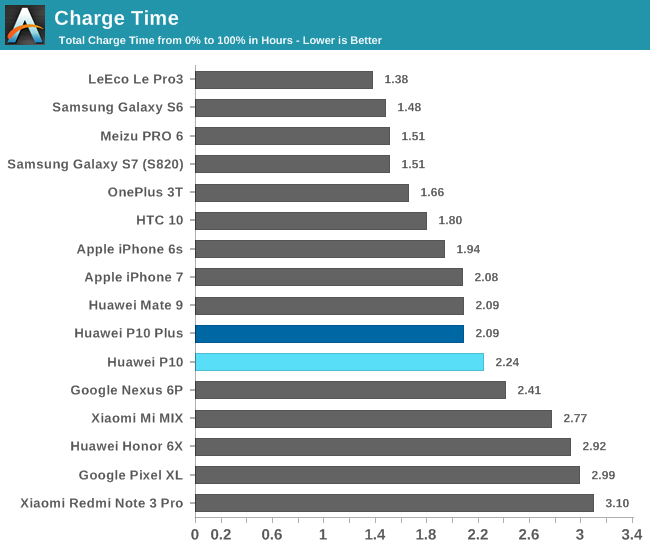
The P10 and P10 Plus include Huawei’s SuperCharge fast-charging technology that includes voltage, current, and temperature protection circuitry. The included wall charger is rated for 5V/2A (10W), 4.5V/5A (22.5W), and 5V/4.5A (22.5W) operation.
The P10 reaches a peak of about 16.2W at the battery shortly after being plugged in before settling around 12.5-13W. The battery charges to 25% in about 14 minutes and reaches 50% in about 31 minutes. The P10 Plus charges a little faster, initially spiking to 17.2W before settling around 14W. The P10 Plus’ battery charges to 25% in about 14 minutes and reaches 50% in about 30 minutes. Both P10s take just over 2 hours to be completely charged.



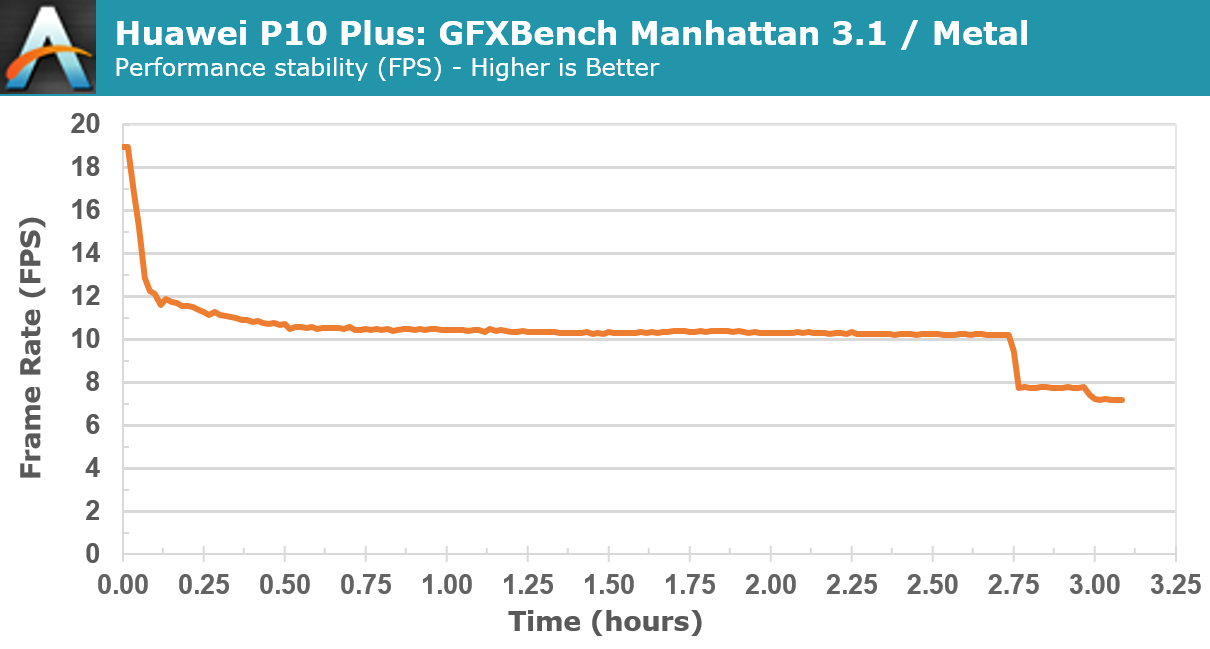
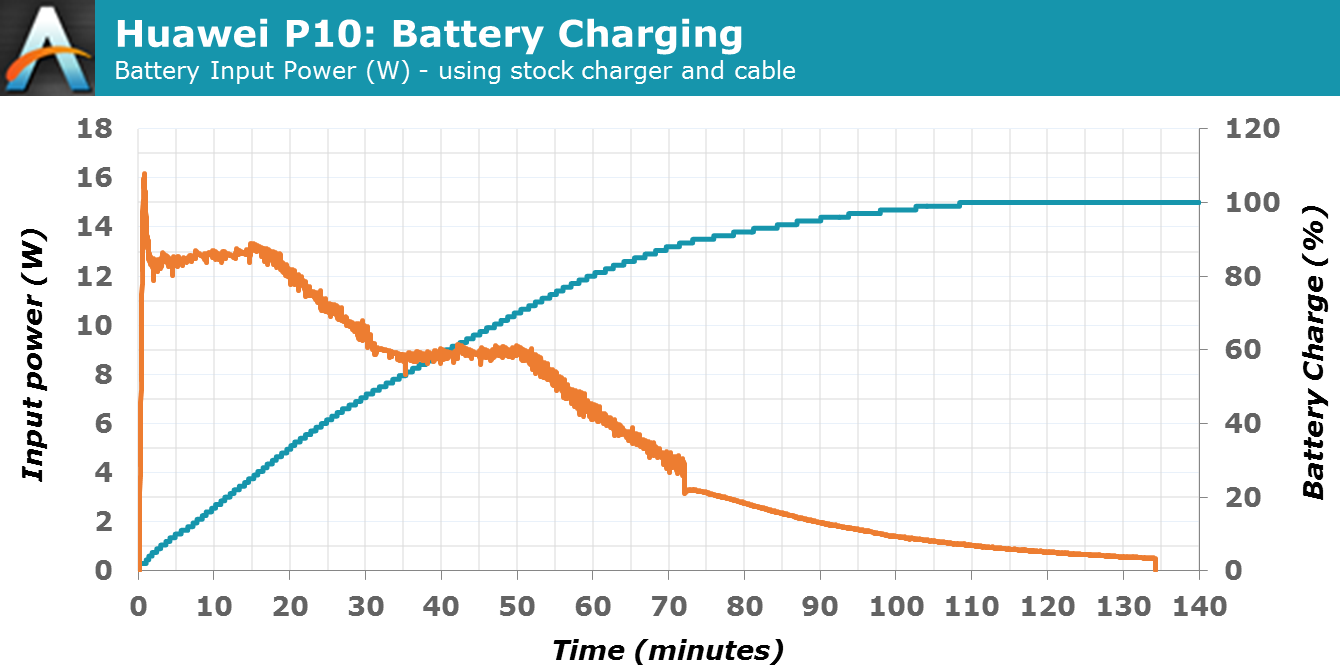
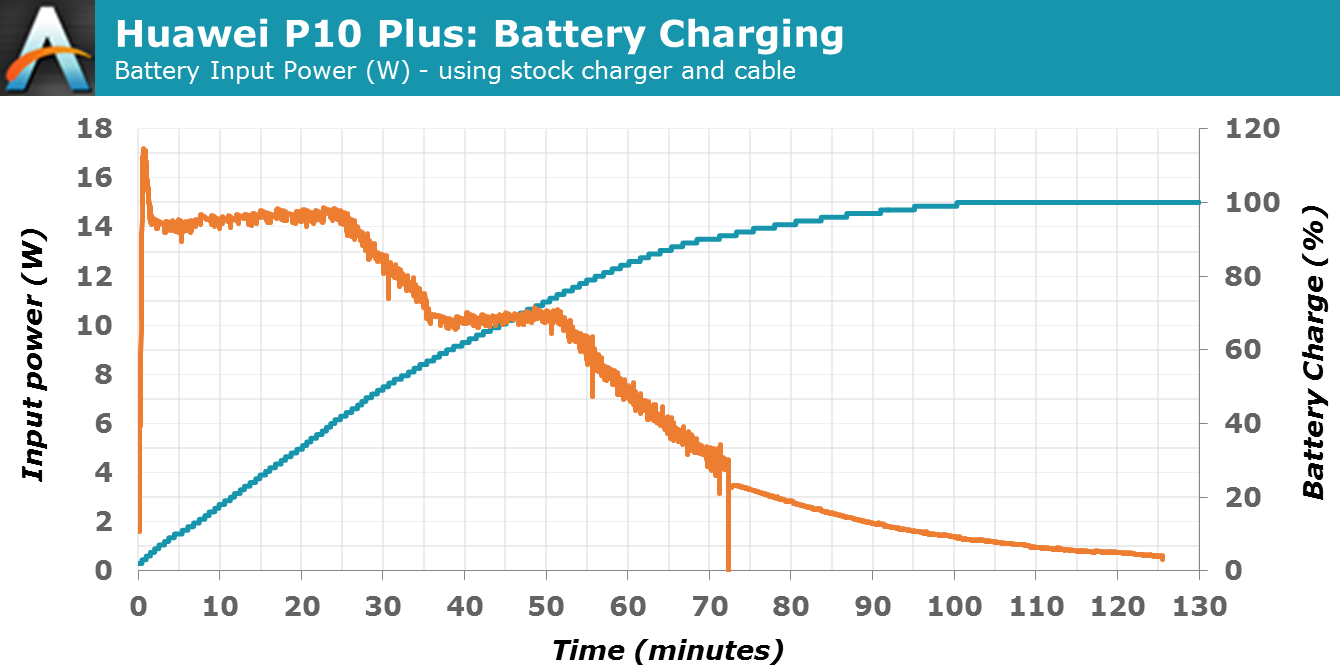








74 Comments
View All Comments
Eden-K121D - Friday, May 12, 2017 - link
It is very hypocritical of a company when they market a Product as a flagship but don't hold them to the same standard. It is very bad that they mislead customers about very much slower emmc and then make rubbish claims of optimization.BurntMyBacon - Friday, May 12, 2017 - link
Roughly equivalent or perceptually equivalent is one thing. Clearly different, as is the case with the flash here, is unquestionably unacceptable. Guess I can mark Huawei off my list of manufacturers to follow.niva - Friday, May 12, 2017 - link
The only Huawei I wanted to buy was the Nexus 6P, and only because Google was in charge of the software running on it. Otherwise I'm really not interested in any Chinese phones, this may be generally true for any non Nexus/Pixel phones but the Chinese have earned a special disdain from me many years ago with their practices/software.So no... I'm not interested in this phone. If you gave me one I'll go ahead and try to sell it immediately.
AlphaBlaster - Sunday, May 14, 2017 - link
Who writes this innocuous crap? "Trump is ruining his political career?" Trump doesn't have a political career. He is a circus clown told what to say by the wealthy few who are running everything, own everything! They put a magpie frontman in that position to guarantee that their status quo is maintained and increases , by design, to their benefit alone, and to the oppression, impoverishment, and murdering of everybody else. "Providing context?" On what? At this stage of the game, the only 'context' any legitimate person should be engaged in is guerilla warfare!kaidenshi - Sunday, May 14, 2017 - link
Did you mix up your AnandTech and Facebook tabs?leexgx - Friday, May 12, 2017 - link
This reminds me of Kingston using different flash that is far slower but nothing on the box to state what it is (only find out when you used it for a bit or do benchmark testss.yu - Saturday, July 29, 2017 - link
If they didn't advertise about specific technology or a specific performance standard the product should reach then you can't fault them, not the case for Huawei.boozed - Monday, May 15, 2017 - link
Did we read the same review?s.yu - Saturday, July 29, 2017 - link
Nice to see more people agreeing with what I've been saying for literally years(since P8), I guess it's inevitable that more discerning customers will come to realize Huawei's deceptive nature as they expand their businesses beyond China. I honestly hope that a company like this would crash into the ground real soon, but I just don't think most of the consumer market is knowledgeable and principled enough for that to happen.virtuastro - Friday, May 12, 2017 - link
I'm glad you said that it's smooth and responsive but not Pixel XL smooth. It's good to know. I want to see how P10/ P10 Plus's camera image quality. But I did saw dxomark review about it.